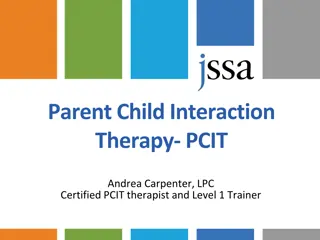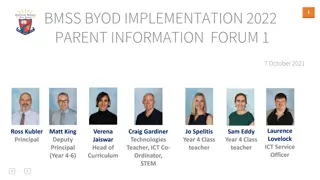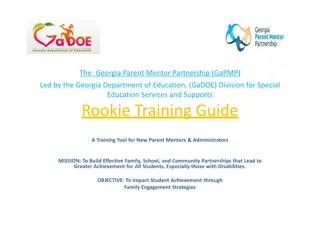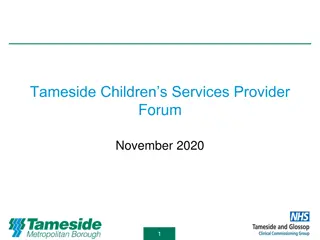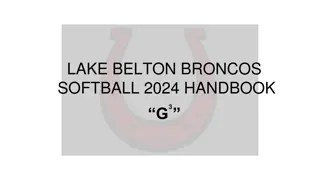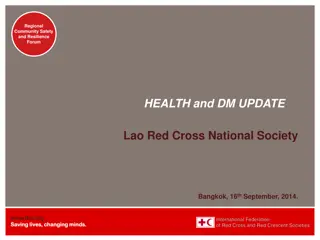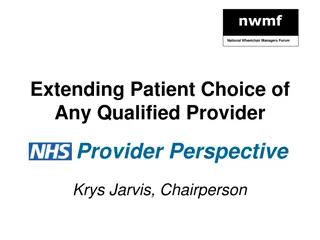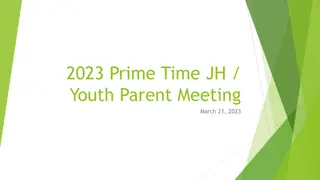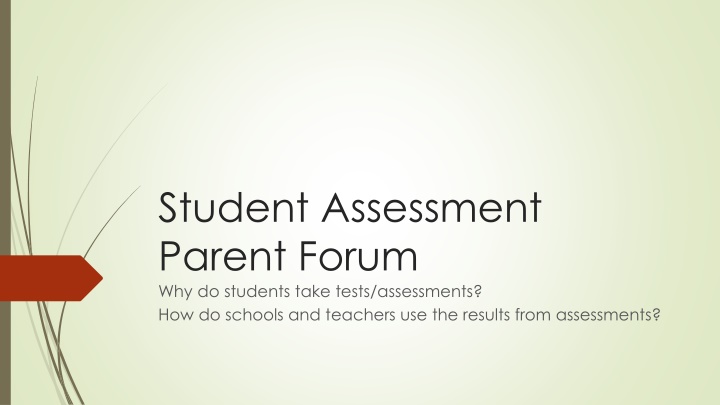
Importance of Student Assessment Data and its Impact on Education
Discover why students take tests and assessments, and how schools and teachers utilize the results to enhance learning outcomes. Explore various types of assessment data collected and stored, and understand the critical role data plays in shaping educational strategies and student success.
Download Presentation

Please find below an Image/Link to download the presentation.
The content on the website is provided AS IS for your information and personal use only. It may not be sold, licensed, or shared on other websites without obtaining consent from the author. If you encounter any issues during the download, it is possible that the publisher has removed the file from their server.
You are allowed to download the files provided on this website for personal or commercial use, subject to the condition that they are used lawfully. All files are the property of their respective owners.
The content on the website is provided AS IS for your information and personal use only. It may not be sold, licensed, or shared on other websites without obtaining consent from the author.
E N D
Presentation Transcript
Student Assessment Parent Forum Why do students take tests/assessments? How do schools and teachers use the results from assessments?
Nothing we do to or for our students is more important than our assessment of their work and the feedback we give them on it. The results of your assessment influence students for the rest of their lives. Race, et al.
THE IMPORTANACE OF ASSESSMENT DATA Asking students to demonstrate their understanding of subject matter is critical to the learning process. Schools use assessment data results to: Ensure that students are meeting grade-level expectations and remain on track for the next grade level and ultimately, high school graduation. (We want to ensure students are prepared for their academic journey year to year. Improve the curriculum, better plan instruction and provide more personalized instruction to address individual student needs. (Are there trends in the data that show an area of weakness? Is the pacing of lessons and curriculum appropriate?) Identify where a student is excelling and/or where s/he needs additional support or enrichment. (Are students properly identified?) Modify instruction as needed. Encourage active learning. Help students identify their own errors and learn from feedback. Support instructional decision making. 1. 2. 3. 4. 5. 6. 7.
TYPES OF DATA COLLECTED Various types of data is collected and used to make fair, sound reasonable instructional decisions. No decision is based on one point of data. Triangulation (multiple points) of data gives a clear picture of student performance. Below are examples of the types of data used: Student grades Math placement tests (IAAT and Pre-Algebra indicator) The Iowa Algebra Aptitude Test, Fifth Ed. Lexile Reading Level, STAR, which is then used by the student and teacher to select text at the appropriate reading level. District writing assessments (Narrative, Informational, Persuasive and Argumentative) Math, English and 8thgrade Science Diagnostic Computer Diagnostic Testing Systems PSSA (Pennsylvania System of School Assessment) - Math, English and 8thgrade Science PASA (Pennsylvania Alternative System of Assessment) alternative assessment for students with severe disabilities Keystone Assessments End of course assessments for Algebra 1, Biology, and Literature PVAAS (Pennsylvania Value Added Assessment System) - Projections (future projections on PSSA)and growth measurements of students versus like peers in the state. 10. Attendance 11. Student Discipline 1. 2. 3. 4. 5. 6. 7. 8. 9.
STUDENT DATA ASSESSMENT WAREHOUSE Student data is stored in a program called Performance Plus
PERFORMANCE PLUS From the example shown, each assessment can be further examined. Questions, answers and performance can be viewed. Teachers can click on specific standards to see how students have mastered the material. (Where are the strengths and areas of improvement?)
MATH DATA USED FOR PLACEMENT Data used for Math Remediation course Data used for Advanced Math Courses 1. PSSA Basic or Below 1. Minimum of 80% on algebra inventory (IAAT) 2. Student grades D or below 2. Advanced in Math PSSA or High Proficient 3. CDT data - basic 4. Math Quarterlies and indicator assessment 3. Student grades in prior class 4. Student achievement historical data 5. Historical data from Performance Plus 5. Teacher recommendation 6. Teacher Recommendation
READING DATA USED FOR PLACEMENT Data used for Reading Remediation Course 1. Teacher recommendation 2. Formative and Summative assessment data - grades 3. PSSA Assessment Score of basic or below basic two years worth or data 4. STAR Data results one year or more below grade level 5. CDT assessment scores Red 6. 5thgrade incorporates DIBELS testing where appropriate 7. Review of Pertinent Data from Performance Plus IE. District writing assessments World Language vs 8thgrade Reading course? 1. Student grades from Reading and English classes in 6thand 7thgrade 2. STAR Results on grade level or above 3. PSSA Assessment score of Proficient or above 4. Teacher recommendation
Pennsylvania System of School Assessment PSSA School usage: 1. State assessment data is used to measure individual student progress over time. Districts use the assessment data to measure the effectiveness of their curriculum, interventions and programs. Test results from the PSSA assessment show how well a student performed in subcategories of skills in each subject to identify strengths and weaknesses Parent usage: 2. 1. Parents can use assessment results as a springboard to start a discussion with teachers about how they can help their child stay on track and learn how they can view their child s progress over time. 2. State assessments measure whether students have achieved what is expected for their grade or course. Parents can use their child s test results to better understand his or her needs and strengths and work with teachers to identify resources that would provide additional support. Student usage: 3. 1. Identify areas of strengths and weaknesses. 2. Engage on active learning 3. Conflict peer/self assessment to foster reflection, critical thinking and self awareness skills.
PSSA OPT OUTS FOR ALL NESHAMINY MIDDLE SCHOOLS IN 2016
MAPLE POINT MS HISTORICAL DATA ON OPT OUTS OF THE PSSA FOR THE LAST THREE YEARS Chart Title 45 40 35 30 25 20 15 10 5 0 5th grade 6th grade 7th grade 8th grade 2014 2015 2016
PSSA OPTING OUT EFFECTS Incomplete picture of student and class performance Eliminates student ability to demonstrate understanding of the subject matter, set goals, and learning from errors. Impedes capacity to identify areas of strengths and weaknesses Attitude of students taking the assessment is affected very difficult to quantify. 1. If they don t have to take the test, Why do I? 2. My parents are making me, I really don t care. 3. This doesn t matter for anything, why should I try? Attitude of students that are opted out 1. My parents think this is a joke. I opted out because my friend did, I didn t even know you could. Attitude of parents opting students out. 2. 1. My student is stressed out by the PSSA 2. I don t believe in assessment. 3. I am opting out because my friend opted their student out.
SCHOOL PERFORMANCE PROFILE SPP EFFECT 2013-14 SPP Score 2015-16 SPP Score 76.6 - 0 Opt outs 59.0 137 opt outs PSSA results have a direct correlation with a school SPP score What happened? Participating rate was reduced - how does the 137 opt-outs from the 2016 PSSA effect the School Performance Profile? How were the students who took the assessment effected by the large number of opt outs? Attitude is a major contributing factor of student performance on the calculation of SPP We need your help!!!
SCHOOL PERFORMANCE PROFILE The SPP score of a 59 represents Maple Point as a failing school. Students, Parents, community members view this number and what is represents. I would whole heartedly disagree. Maple Point s strong academic and extracurricular programs prepare students and continues the process of building futures for each child in the Neshaminy School District. Maple Point has done the following to improve our SPP. 1. Reviewed the data available to identify emerging trends that show areas of improvement needed in ELA, Math, and Science for instruction. 2. Teachers have participated in professional development that addresses student areas of weaknesses (Both tested and non-tested subjects). 3. Administration has reviewed current student data and has made changes in students schedules to support these areas where students are struggling. (IE rescheduling WIN classes to add support, creating 5thgrade extra math groups to give added support). 4. Teachers have flexed their clinic times to offer more support. 5. Teachers have created PVAAS action plans that address instruction and growth of students along with reviewing PSSA projections of students. 6. Outreach to parents through these forums. 7. Scheduled grade level WIN meetings in March with students to encourage students to do their best and the expectations for the test. Review of strategies for assessment will occur. 8. Recognition of academic performance.




